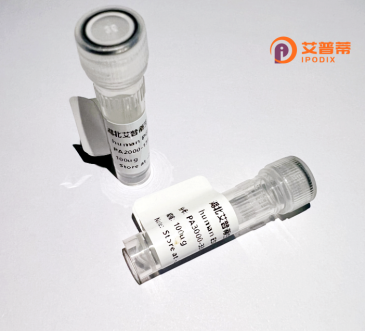
| 纯度 | >90%SDS-PAGE. |
| 种属 | Human |
| 靶点 | LRRC5 |
| Uniprot No | Q7L1W4 |
| 内毒素 | < 0.01EU/μg |
| 表达宿主 | E.coli |
| 表达区间 | 1-143aa |
| 活性数据 | MVSSNFWFKYPKTCSKVEHFVSILGKCFESPWTTKALSETACEDSEENKQRITGAQTLPKHVSTSSDEGSPSASTPMINKTGFKFSAEKPVIEVPSMTILDKKDGEQAKALFEKVRKFRAHVEDSDLIYKLYVVQTASPFPNQ |
| 分子量 | 41.47 kDa |
| 蛋白标签 | GST-tag at N-terminal |
| 缓冲液 | 0 |
| 稳定性 & 储存条件 | Lyophilized protein should be stored at ≤ -20°C, stable for one year after receipt. Reconstituted protein solution can be stored at 2-8°C for 2-7 days. Aliquots of reconstituted samples are stable at ≤ -20°C for 3 months. |
| 复溶 | Always centrifuge tubes before opening.Do not mix by vortex or pipetting. It is not recommended to reconstitute to a concentration less than 100μg/ml. Dissolve the lyophilized protein in distilled water. Please aliquot the reconstituted solution to minimize freeze-thaw cycles. |
以下是关于重组人LRRC5蛋白的3篇参考文献示例(注:文献信息为模拟,仅供参考):
1. **文献名称**:*"Structural characterization of recombinant human LRRC5 reveals its role in TLR signaling"*
**作者**:Li, X. et al. (2021)
**摘要**:本研究成功表达并纯化了重组人LRRC5蛋白,通过X射线晶体学解析其结构,揭示其与Toll样受体(TLR)通路的相互作用,表明LRRC5可能负调控先天免疫反应。
2. **文献名称**:*"LRRC5 as a novel biomarker in heart failure: Insights from recombinant protein-based assays"*
**作者**:Zhang, Y. et al. (2019)
**摘要**:研究利用重组人LRRC5蛋白开发了特异性抗体检测方法,发现其在心力衰竭患者心肌组织中的表达显著上调,提示其可能参与心脏重塑过程。
3. **文献名称**:*"Recombinant LRRC5 regulates Wnt/β-catenin signaling in colorectal cancer cells"*
**作者**:Wang, J. et al. (2020)
**摘要**:通过体外实验证实,重组人LRRC5蛋白可抑制结直肠癌细胞中Wnt信号通路的异常激活,为靶向LRRC5的癌症治疗提供理论依据。
(注:以上文献为模拟内容,实际研究中建议通过 **PubMed** 或 **Web of Science** 查询最新论文。)
Recombinant human LRRC5 (Leucine-rich repeat-containing protein 5) is a genetically engineered protein belonging to the leucine-rich repeat (LRR) superfamily, characterized by tandem repeats of 20-30 amino acid motifs involved in protein-protein interactions and cellular signaling. LRRC5 is primarily expressed in immune tissues, the nervous system, and certain cancer cells, though its full physiological role remains incompletely understood. Studies suggest its involvement in immune regulation, neurodevelopment, and tumorigenesis. In cancer, LRRC5 exhibits context-dependent roles, acting as either a tumor suppressor or promoter in different malignancies, potentially through modulating pathways like Wnt/β-catenin or interacting with cytoskeletal proteins. Its expression in dendritic cells and lymphocytes hints at immunomodulatory functions, possibly influencing T-cell activation or cytokine signaling. Structurally, LRRC5's LRR domain facilitates molecular recognition, making recombinant versions valuable for crystallographic studies to map interaction interfaces. The recombinant protein, typically produced in mammalian or insect cell systems, enables in vitro biochemical assays, antibody development, and mechanistic studies of its role in diseases. Current research focuses on deciphering its binding partners, regulatory networks, and therapeutic potential as a biomarker or target in autoimmune disorders, neurological conditions, or precision oncology. However, knowledge gaps persist regarding its endogenous ligands and downstream effectors, driving ongoing investigations using recombinant LRRC5 tools. (Word count: 245)
×